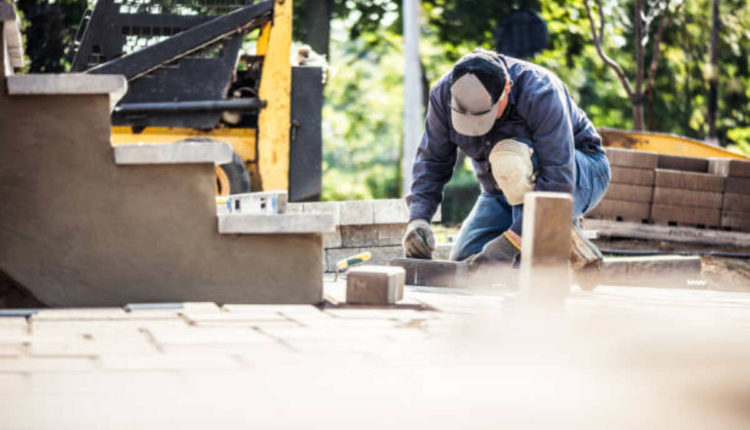Patio Flagstone Setup
High-end landscape installations use materials that have a natural feel, which you can see for yourself if you take a look around. Artificial materials are the antithesis of attractive landscaping. Landscaping is done so that people can enjoy being outside. This is why patio and pathway flagstone is commonly used in upscale landscaping. Selected flagstone is the material of choice for high-end landscaping. Some of the pieces are far larger than usual. Then, moss or thyme is sown into the crevices between the flagstones. Moss and thyme prevent weeds from growing, secure the stones, and provide delicate, showy blossoms. The ideal Elfin Thyme variety is the low-growing and wide variety.
A strong back, shovel, pick, boots, gloves, level, two-by-four, massive mason chisel, tiny sledgehammer, assistant, and a skill saw with a diamond blade are all needed to finish this project successfully. You might also need a bender board, pegs, and metal landscape edging.
Natural Charm
Some stones stand out. There are iridescent tones of gray, white, red, blue, and green and tortoiseshell tones of green. They seem to be reflecting your welcoming glow. Using a variety of stones in a variety of colors and cuts can yield some quite stunning results. Irish Moss and Elfin Thyme add natural beauty while cooling the hot stone.
Pricing
The average cost of self-installation is $5 per square foot. The going rate per square foot for labor is around $10.00 to $15.00.
Setup Instructions
To Excavate Soil
If required, start by removing the soil. Set the height limit for the patio and stake out its perimeter. Six inches of digging is usually needed. The stone, gravel base, and sand measure 2 inches thick.
Put in Edges (if desired)
Use bender board or metal landscape edging to secure the edges. This is discretionary. Larger, carefully chosen stones don’t need edging to stay put. If you use smaller patio stones, you’ll need additional edging.
Compaction
After you’ve finished excavating, it’s important to compact the soil. You can use either a hand tamper or a plate compactor, both available for rent at most construction supply outlets. Add two inches of gravel or road base to the compacted bottom and repeat the process.
Fill Material & Road Gravel
Road base is the superior option for larger projects. The gravel and dirt that make up the state-mandated road base. It’s excellent for making roads and will do the trick for your patio. In any case, fine gravel will do in a pinch. The finer gravel is the better option for compactness and ease of use. Coarse gravel is recommended due to its superior compaction. Pea gravel, or coarse sand, is a suitable option.
Sand
There is no uniformity to the stones. Sand is required for stone height adjustment. Over the compacted base, spread sand to a depth of a couple of inches. The sand needs to be gritty. Coarse sand, like gravel, compacts more effectively.
Flagstone Installation
Two individuals are required to move and set the stone. Break the rock using a little sledgehammer and a blue mason’s chisel protected by a yellow handle. The work will be broken up by nature. A diamond-tipped skill saw can also be used, although the results won’t be quite as seamless. Small wet saws won’t be able to cut through anything. You will receive large and tiny stones if your order is processed correctly. As a result, less time will be needed to trim.
A straight two-by-four helps check whether or not the stone is level. Place it flat on the rock and search for indentations. The two-by-four can also serve as a leveling tool.
It’s preferable if the stone is not entirely flat. Water needs to be able to run off the patio. Therefore a slight incline is necessary. A 14-inch-per-foot slope is recommended for decks.
Stone on Order
About 80-125 square feet can be covered with one ton of flagstone. There are a lot of unknowns. The weight and thickness of stones might differ. Find out from your stone yard what specific stone they have in stock. The typical coverage area of one ton of flagstone is 125 square feet. The space between the rocks is one such factor. Get the most outstanding results by ordering carefully. Smaller patio stones are often used to fill in more significant gaps. It’s cheaper than buying the larger stone and breaking it up yourself.
Request for Gravel
One ton will cover around eighty square feet at a depth of two inches.
Sand Purchased
One ton will cover around 124 square feet at a depth of two inches.
Quantifying in Tons
Dimensions in (L x (W x (H)) / 27 = Yards. Then, there will be a disparity in the weights of the various goods. Each product requires a unique multiplier. To approximate, multiply numbers by 1.5. To acquire the required number of tons, multiply the yards by 1.5. More tons than yards can be expected. The multiplier for sand is 1.2, whereas for gravel is 1.4. A 1.5 is reasonable for Flagstone.
Last Words
Polymeric sand can also be used in the spaces between the stones. It seems like sand but becomes as hard as concrete after three thin coats of water. Flagstone can be used on dry cement if the area is prone to shifting. The glue must next be diluted with water to cure and harden.
Visit Outdoor Wet Area with Plants for More Details.
Read also: Paint the Walls in a Whitewash Bedroom Furniture Decoration
